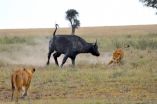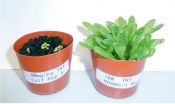Shared habitats
Dangerous drug-resistant superbugs happily co-exist in the gut but can be eliminated by fecal transplants
2015-09-03
(Press-News.org) The gut is an important reservoir for drug-resistant bacteria responsible for life-threatening hospital-acquired infections. A study in mice published on September 3rd in PLOS Pathogens reports that two of the most common antibiotic-resistant bacterial species circulating in hospitals occupy and effectively share the same location in the gut, and that they can be eliminated by fecal transplantation of a healthy gut microbiome.
Eric Pamer, from Memorial Sloan-Kettering Cancer Center in New York, USA, and colleagues, investigated the interactions between vancomycin-resistant Enterococcus faecium (VRE) and multi-drug resistant Klebsiella pneumoniae in the intestinal environment. Together, the two pathogens are responsible for about 10% of serious hospital-acquired infections in the US. Both can colonize the gut and spread from there, to the same or other patients, to cause localized or systemic infections.
Using a mouse model of intestinal colonization, the researchers first asked whether intestinal domination by either VRE or K. pneumonia would provide resistance against colonization by the other pathogen. They found that VRE and K. pneumoniae occupy the same intestinal sites and neither compete nor synergize with each other upon dense colonization of the mouse gut. While peacefully co-existing, the researchers found that the two pathogens differ with respect to stimulation and invasion of the colonic mucus, suggesting that they reside in distinct niches that satisfy their specific metabolic needs.
It is known that transplantation of feces from healthy mice can eliminate VRE from the intestine of densely colonized mice and, in humans, fecal transplantation from healthy donors can cure patients with certain pathogenic intestinal infections. To determine whether fecal transplantation can clear K. pneumoniae and concurrent VRE and K. pneumoniae infections, the researchers colonized mice with VRE and K. pneumoniae concurrently and then treated them with fecal microbiota transplants (FMT) or a sterile control solution on three consecutive days.
They found that VRE and K. pneumoniae levels were similar in the feces before FMT administration and remained elevated in mice that received the sterile control solution. In contrast, following FMT treatment, K. pneumoniae density in fecal pellets decreased within one day and became undetectable within 7 days in all mice. VRE, on the other hand, was cleared in 60% of the mice and reduced by a thousand-fold in the remaining 40%.
The researchers conclude that their findings "uncovered previously unrecognized features of VRE and K. pneumoniae colonization and provide insight into the nature of pathogen coexistence, dissemination and ways to eradicate colonization". "Current efforts", they say, "are focused on the identification of commensal bacterial species [i.e. the components of the healthy fecal transplant] that mediate clearance of antibiotic-resistant bacteria".
INFORMATION:
Please use this URL to provide readers access to the paper (Link goes live upon article publication):
http://dx.plos.org/10.1371/journal.ppat.1005132
Related Image for Press Use:
https://www.plos.org/wp-content/uploads/2013/05/Pathogens_Pamer_SEP3_IMG.jpg
Caption: Left, commensal bacteria (red) in the intestine are kept at a distance from the colonic tissue by a thick layer of mucus (green). Antibiotics perturb the integrity of the mucus layer, facilitating invasion by some bacterial species such as Klebsiella pneumoniae (middle) and to a lesser extend VRE (right). Infiltration of the colonic mucus layer may prove to be a critical step in bacterial spread to other sites including the bloodstream.
Credit: Silvia Caballero, CC-BY
Authors and Affiliations:
Silvia Caballero; Memorial Sloan-Kettering Cancer Center, USA; Weill Cornell Graduate School of Medical Sciences, USA
Rebecca Carter; Memorial Sloan-Kettering Cancer Center, USA
Xu Ke; Sloan-Kettering Institute, USA
Bože Sušac; Memorial Sloan-Kettering Cancer Center, USA
Ingrid M. Leiner; Memorial Sloan-Kettering Cancer Center, USA
Grace J. Kim; Memorial Sloan-Kettering Cancer Center, USA
Liza Miller; Memorial Sloan-Kettering Cancer Center, USA
Lilan Ling; Memorial Sloan-Kettering Cancer Center, USA
Katia Manova; Sloan-Kettering Institute, USA
Eric G. Pamer; Memorial Sloan-Kettering Cancer Center, USA; Weill Cornell Graduate School of Medical Sciences, USA
Please contact plospathogens@plos.org if you would like more information.
Funding: This work by supported by grants from the US National Institutes of Health RO1 AI42135 and AI95706, the Tow Foundation and the Lucille Castori Center for Microbes, Inflammation and Cancer to EGP. SC was supported by the Gilliam Pre-doctoral Fellowship from the Howard Hughes Medical Institute. XK and KM were supported by the Core grant P30 CA008748 from the Molecular Cytology Facility at Memorial Sloan-Kettering Cancer Center. The funders had no role in study design, data collection and analysis, decision to publish, or preparation of the manuscript.
Competing Interests: The authors have declared that no competing interests exist.
Citation: Caballero S, Carter R, Ke X, Sušac B, Leiner IM, Kim GJ, et al. (2015) Distinct but Spatially Overlapping Intestinal Niches for Vancomycin-Resistant Enterococcus faecium and Carbapenem-Resistant Klebsiella pneumoniae. PLoS Pathog 11(9): e1005132. doi:10.1371/journal.ppat.1005132
[Attachments] See images for this press release:

ELSE PRESS RELEASES FROM THIS DATE:
2015-09-03
Much like birds fly in flocks to conserve energy, dolphins swim in pods to mate and find food, and colonies of ants create complex nests to protect their queens, immune cells engage in coordinated behavior to wipe out viruses like the flu. That's according to a new study published today in the journal Science by researchers at the University of Rochester School of Medicine and Dentistry.
The findings reveal, for the first time, how immune cells work together to get to their final destination - the site of an injury or infection. The body is expansive and a virus or bacteria ...
2015-09-03
WASHINGTON, DC (September 3, 2015)-- The District of Columbia's needle exchange program prevented 120 new cases of HIV infection and saved an estimated $44 million over just a two-year period, according to a first-of-a-kind study published today by researchers at the Milken Institute School of Public Health (Milken Institute SPH) at the George Washington University.
"Our study adds to the evidence that needle exchange programs not only work but are cost-effective investments in the battle against HIV," says Monica S. Ruiz, PhD, MPH, an assistant research professor in ...
2015-09-03
Why are there not more lions when there's plenty of prey on the African savanna?
A research team including two University of Guelph ecologists has discovered an unexpected pattern linking prey and predator species in diverse ecosystems worldwide.
Integrative biology professors John Fryxell and Kevin McCann co-authored the paper, published today in Science. The team included researchers at McGill University, the University of British Columbia and the Perimeter Institute for Theoretical Physics in Waterloo, Ont.
Beyond lions and the gazelles they hunt on the African ...
2015-09-03
This news release is available in Japanese.
Regular exposure to bacteria particles and farm dust protects children from allergies because it blunts their inflammatory immune responses, a new mouse study suggests. The study implicates a particular anti-inflammatory enzyme, A20, in this protective effect. While aspects of how allergies develop remain unclear, scientists know they're driven not only by genes but also by environment. Homes with pets, as well as dairy farms - where children breathe dust containing higher doses of fungal particles, cowshed-derived bacteria ...
2015-09-03
This news release is available in Japanese.
Ecological communities around the world are richly varied, but a new study finds that many of these diverse communities follow an unexpected, yet consistent pattern: where prey are abundant, there are not proportionally more predators. Instead, as prey biomass increases, the ratio of predator-to-prey biomass decreases. This pattern was systematically identified across different areas, including grasslands, forests, lakes, and oceans, revealing an underlying structural organization of ecosystems. Pinpointing underlying ...
2015-09-03
This news release is available in Japanese.
Researchers have identified a mutation in plants that allows them to break down TNT, an explosive that has become highly prevalent in soil in the last century, particularly at manufacturing waste sites, mines, and military conflict zones. TNT, or 2,4,6-trinitrotoluene, is a toxic and persistent environmental pollutant that accumulates in the roots of plants, inhibiting growth and development. The identification of a plant mechanism that not only evades the negative impacts of TNT, but breaks down this harmful substance could ...
2015-09-03
This news release is available in Japanese.
A special news edition, Science in Iran, looks closely at the scientific challenges and triumphs of a country that has faced international isolation in recent years. Following an exclusive interview about the Iran nuclear deal with Ali Akbar Salehi, president of the Atomic Energy Organization of Iran, Science International News Editor Richard Stone delves further into the state of Iran's scientific endeavors. Decades of economic sanctions have deprived Iranian scientists of critical scientific resources and collaboration. ...
2015-09-03
Biologists at the University of York have taken an important step in making it possible to clean millions of hectares of land contaminated by explosives.
A team from the Centre for Novel Agricultural Products (CNAP) in the University's Department of Biology has unravelled the mechanism of TNT toxicity in plants raising the possibility of a new approach to explosives remediation technology. TNT has become an extensive global pollutant over the last 100 years and there are mounting concerns over its toxicity to biological systems.
The study, which is published in Science, ...
2015-09-03
Researchers at VIB (a leading life sciences institute in Flanders, Belgium) and Ghent University have successfully established a causal relationship between exposure to so-called farm dust and protection against asthma and allergies. This breakthrough discovery is a major step forward towards the development of an asthma vaccine. The results of the research were published in the leading journal Science.
It is commonly known that drinking raw cow's milk can provide protection against allergies. A 14-member research team, led by professors Bart Lambrecht and Hamida Hammad ...
2015-09-03
Evidence from a new study published in PLOS Computational Biology by researchers from Brown University and led by Assistant Professor Thomas Serre suggests that when we analyze scenery we simply make the easiest judgments first, rather than following a priority order of categories.
There are many ways we understand scenery. Is it navigable or obstructed? Natural or man-made? A face or not a face? In previous experiments, researchers have found that some categorization tasks seem special, in that they occur earlier than others, leading to a hypothesis that the brain has ...
LAST 30 PRESS RELEASES:
[Press-News.org] Shared habitats
Dangerous drug-resistant superbugs happily co-exist in the gut but can be eliminated by fecal transplants




